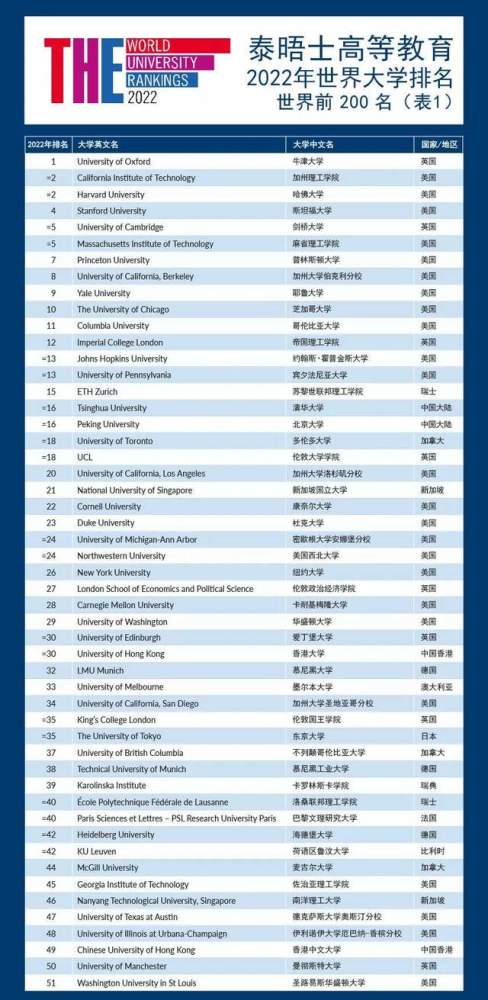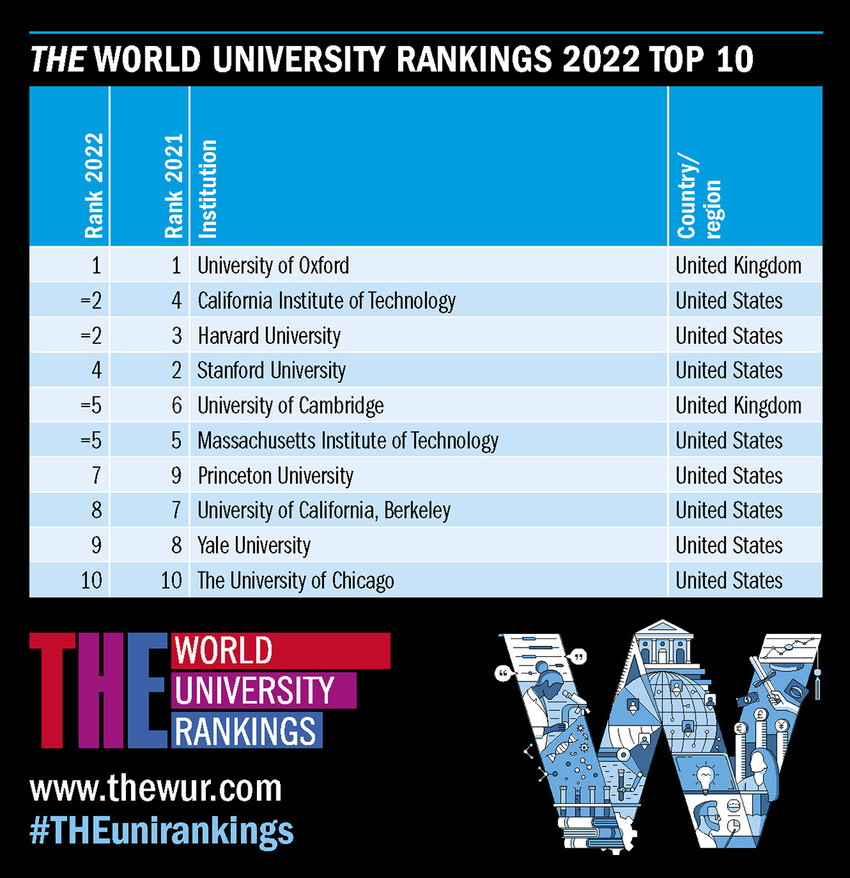中国3所「985大学」拒绝再上国际排名
世界新闻网
5/08/2022

中国南京大学近期在文档中明确表示,学校发展和学科建设均不再使用国际排名作为重要建设目标。未来,南京大学也不会给国际排名机构提供任何数据。早在南京大学之前,中国人民大学和兰州大学也已经对国际排名说不,也不给国际排名机构提供任何数据。
据腾讯新闻,近年来国际各大商业排名机构出具了多个大学排名,尤其是国际排名,引起社会广泛关注。但教育界苦于国际各大学排行榜久矣。其实,国际排名不可靠,3所ㄓ「985大学」(又称985院校,中国为了建设若干所世界一流大学和一批世界著名高水准研究型大学而实施的教育计划)明确拒绝国际排名,不提供任何数据。
文章称,国际商业排名机构的指针设置不一样,同一个指针的权重也不尽相同,导致出具的排名五花八门,甚至同一所大学,在不同的排名机构中,得出的排名能差几十甚至上百名,真是让人大跌眼镜。
英国的泰晤士高等教育排行榜,将英国的牛津和剑桥排在世界前两名,而美国的几个排行榜,又把美国的大学排在世界第一。可以说,这些商业排名机构出具的排名并不权威,也不怎么可靠。
但是一些中国的大学,却以这些国际排名机构的排名作为自己的奋斗目标,甚至根据这些排名机构的指针来量身定制发展策略,导致走上了弯路。一些大学甚至邀请这些国际排名机构QS的负责人去交流,让人浮想联翩。
国外排名机构出具的排名,将国际学生占比和国际教师占比,这两个指针的权重定得很高,对中国的大学产生了很大的误导性作用。
国外的大学,尤其是英美和澳洲,本就是留学大国,留学生占比很高,甚至英国一些大学,中国留学生的人数能占学校总人数的三分之一以上,在这种情况下,国外的排名机构将国际学生占比提高,就是为了让欧美的大学更有排名优势。
文章称,中国一些大学却也盲目追随国外的标准,为了在国际学生占比指针方面获得优势,降低标准招收外国留学生,不仅侵占了国内学生的资源,还引发了一些更大的问题,对学校的声誉造成了很大影响。
最新世界大学排名:清、北创历史,收入超上市公司
文章来源: 市界
9/02/2021
9月2日,涵盖全球1662所大学的THE世界大学排名,由泰晤士高等教育正式发布。
值得一提的是,北京大学和清华大学,并列总榜单第16名,以及亚洲榜第1位,处于领跑地位。这是首次中国两所大学进入前20名,也是亚洲国家迄今为止的大学最高排名,堪称历史性突破。而在亚洲排在第3~5位的分别为新加坡国立大学、香港大学以及东京大学。
也就是说,在整个亚洲前五,中国高校拿到3个席位,成绩喜人。
当然,如果算上排在第7位的香港中文大学和第9位的复旦大学,在整个亚洲前十中,中国高校拿到5个席位,占据半壁江山。


不过,如果与英美相比,中国高校的确还是存在差距。
通过榜单可看出,排在世界前14的高校所在地区,全部为美国和英国,其中美国占据11个席位,包括加州理工、哈佛以及斯坦福等知名院校,英国则占据3个席位,包括牛津、剑桥等国内民众同样耳熟能详的名字,紧接着便是瑞士的苏黎世联邦理工学院和中国的清华和北大。

那么,身为中国排名最高的前两所高等院校,同时拥有“中国最高学府”之称的清华和北大,到底有多牛?
据北京大学公布的数据显示,其2021年收入总预算为221.3亿元,较2020年增加近30亿元,包括上年结转的53.2亿元。此外,清华大学公布的2021年收支总预算为317.3亿元,比前一年增加6.5亿元,除去上年结转88.5亿元,本年收入预算高达228.8亿元。
实际上,高达两三百亿的年收入,是绝大多数A股上市公司无法企及的。
东方财富Choice数据显示,以2020年为例,营业总收入达上千亿的上市公司为84家(营收破千亿的排名最后的一家为三一重工),营业总收入破500亿的有189家(最后一家为宁德时代)。与清华和北大相比,营业总收入在317.3亿元和221.3亿元以上的A股上市公司,分别为252家和338家,而A股上市公司总数量高达4400多家。
换言之,清华和北大的年收入,分别超过了94.3%和92.3%的A股上市公司。


These are the best universities in the world for 2022
By Phil Baty
9/02/2021

Image: Photo by Adrian Dascal on Unsplash
- UK’s University of Oxford retains first place in the Times Higher Education World University Rankings for the sixth consecutive year as the US and UK take all top ten positions for the second year running.
- In Asia, mainland China registers its highest ever position in the ranking (16th) and sees a record 10 universities reach the world top 200, while South Korea, Japan, Singapore and Hong Kong all achieve their highest positions under the current methodology.
- Dramatic improvements for the Middle East, as Saudi Arabia and Egypt emerge as the fastest-rising countries in the world.
- A record 1,662 universities from 99 countries and regions are part of this year’s rankings as the competition in the global knowledge economy intensifies.
The University of Oxford, which led the way in the global search for a Covid-19 vaccine, has been named the world’s number one university for a sixth consecutive year in the Times Higher Education World University Rankings – in a period when the global rush for research into the virus has provided a further boost to mainland China’s rapid rise up the global rankings.
Oxford came top from a record 1,662 universities from 99 countries and regions that made it into the ranking, which is based on 13 balanced performance indicators and includes an analysis of 108 million citations from 14.4 million research publications – designed to recognise universities’ role in spreading new knowledge – as well as a survey of 22,000 academics worldwide.

Harvard University took its highest position in the rankings since the current methodology was introduced in 2016, claiming second place, a position it shares with its much smaller West-coast US counterpart, the California Institute of Technology. The US claimed eight of the world’s top ten places, with the UK’s University of Cambridge in 5th place, joining Oxford as the only other top ten representatives.

Mainland China continued its rapid rise up the rankings, claiming its highest ever position with both Tsinghua and Peking universities in Beijing sharing joint 16th place – giving the mainland two top-20 positions for the first time. Mainland China claimed a record 10 of the world’s top 200 universities, up from seven last year, and just two back in 2016. Hong Kong also improved its showing at the top of the table, as four of its universities appeared in the top 100 for the first time, and registering its highest ever position in the ranking with the University of Hong Kong taking 30th place.
Success for mainland China and Hong Kong contributed towards a very strong year for East Asia in the higher echelons of the ranking, with the National University of Singapore moving up from 25th to 21st, Japan’s University of Tokyo edging up one place to =35th and South Korea’s Seoul National University moving up six places to 54th. All these results represent national bests for the countries in the table.


Louise Richardson, vice chancellor of Oxford University, told Times Higher Education: “My colleagues and I are absolutely delighted to have achieved the top ranking again. There are many great universities around the world and we are proud to be in their company.
“This past year has demonstrated to our publics, our governments, and even to ourselves just how much universities can contribute to society. The vaccine Oxford developed is being distributed in over 170 countries and over a billion doses have been manufactured. Together our universities have made the strongest possible case for renewed public investment in research universities.”
This is the first year that research into Covid-19 had an impact on the rankings data, reflecting the vital role of universities in understanding and managing the crisis and providing China with a significant boost, as several of its universities including Wuhan University (157th) and Capital Medical University (501-600 band) saw moves up the table as a result of highly cited research into the virus.
The Middle East and North Africa region also saw major improvements in the rankings. Saudi Arabia entered the world top 200 for the first time, with King Abdulaziz University reaching 190th place. The Kingdom claimed five top-400 universities, up from just two last year. Five new entrants from Saudi Arabia gave the Kingdom a record 15 representatives in the rankings.
Saudi Arabia joined Egypt as home to the fastest-rising universities in the world – improving more quickly over the last four years than mainland China, albeit from a lower base. The success for these nations was largely driven by major improvements in scores for research impact – based on citation analysis.
Other rapidly-developing countries included Malaysia, which boasts the fastest-rising higher education in terms of international outlook (attracting academic and student talent, and publishing internationally collaborative research) and Pakistan, which saw a significant boost to its scores for university-industry collaboration.
JOHNS HOPKINS NO. 13 IN ‘TIMES HIGHER EDUCATION’ WORLD UNIVERSITY RANKINGS
Publication evaluates more than 1,600 universities from around the world based on teaching, research, citations, knowledge transfer, and international outlook metrics
Hub staff report
9/02/2021
Johns Hopkins University ranks No. 13 in the annual Times Higher Education World University Rankings for 2022, which were published online Wednesday and include 1,662 colleges and universities from around the globe.
Johns Hopkins share the No. 13 ranking this year with Penn. JHU was ranked 12th globally by THE last year and has been 12th or 13th in each of the past five rankings cycles.
Hopkins also ranks No. 10 overall among 183 U.S. schools, according to THE.
The University of Oxford tops this year’s world rankings, followed by Harvard, Caltech, and Stanford. MIT and Cambridge are tied for fifth.
The Times Higher Education list, published each year since 2004, is among the world’s most influential rankings of colleges and universities, which are judged based on 13 key performance indicators grouped into five thematic areas:
- Teaching, which examines the reputation of the school’s academic instruction as well as student-to-teacher ratios, the ratio of doctoral degrees to bachelor degrees awarded, the number of faculty who hold doctorates, and the income of academic staff
- Research, which analyzes the number of publications per staff member at an institution, the research income of the school, and the reputation of that research
- Citations, which examines the school’s research influence
- Industry income, which measures knowledge transfer by quantifying the income generated by research partnerships with private industries
- International outlook, which weighs the percentage of international staff, students, and co-authorship to determine a school’s ability to attract students, faculty, and staff from around the world








